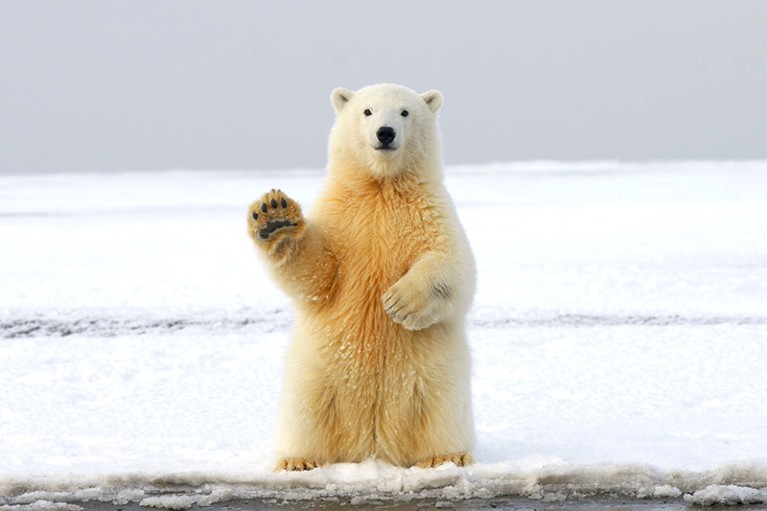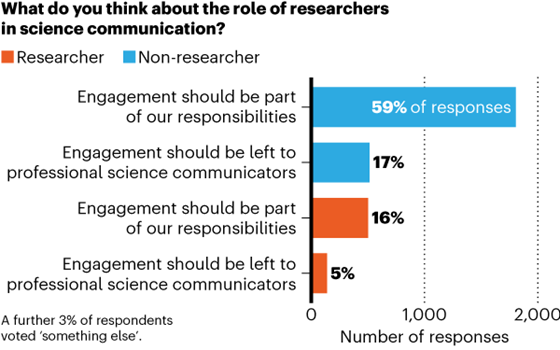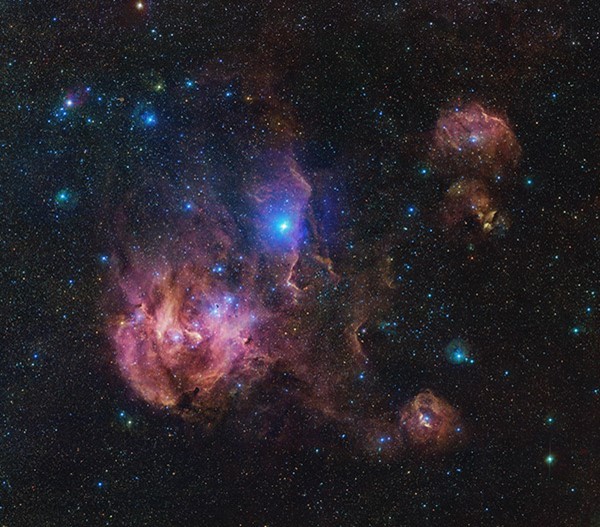Hello Nature readers, would you like to get this Briefing in your inbox free every day? Sign up here.

Chinese scientists have created a sweater as snuggly as this bear, using synthetic fibres.Credit: Belfalah Soufian/500px via Getty
Extra cosy jumper mimics polar bear fur
A sweater knitted from a fibre that mimics polar bear fur offers as much warmth as a down jacket, despite being one-fifth as thick. Each strand of the fabric, an aerogel coated with polyurethane, has a porous core similar to polar bear hair. A brave volunteer tested the jumper into a room chilled to −20 ℃. The knitwear was found to be warmer than cotton and wool. The fibre can also be dyed, washed and stretched, with no apparent loss of snuggliness.
AI-powered robot chemist aces experiments
This robotic chemist might be the ideal laboratory partner: it scours the literature for instructions, designs an experiment and then carries out reactions to make compounds including paracetamol and aspirin. The system, called Coscientist, is powered by several large language models, including GPT-4 and Claude. It “can do most of the things that really well-trained chemists can do”, says Coscientist co-developer Gabe Gomes. Because of the potential of misuse, Gomes’s team hasn’t yet made Coscientist’s full code freely available.
Cancer-fighting cells made inside body
Viruses that infect immune cells could turn them into cancer-targeting agents — without having to remove the cells from the person receiving treatment, genetically edit them and then reintroduce them to their body. Genetically engineered chimeric antigen receptor (CAR) T cells have yielded dramatic recoveries from some blood cancers — but are notoriously expensive and technically difficult, placing them out of reach for many people. In tests with monkeys, an injection of a virus that inserts genes into the animal’s immune cells mimicked the action of approved CAR-T therapies.
Reader poll

Earlier this month, climate scientist Daniel Swain described how he put his research on hold to answer journalists’ questions when wildfires engulfed California in 2020. He suggests that many others with relevant expertise would be prepared to do the same, but that a lack of support from institutions is holding them back.
Three-quarters of readers, both researchers and non-researchers, agreed that public engagement should be part of scientists’ responsibilities. Many cautioned that researchers shouldn’t be put under pressure: those who want to share their expertise should receive support and training, but it shouldn’t be mandatory.
Public engagement “should be compensated and incentivized in recruitment and career progression, rather than frowned upon or seen as yet another unpaid set of tasks over and above an already heavy workload”, adds environmental scientist Helen Avery.
“I would love it if my role didn’t need to exist,” says climate-science communicator Brian Barnes. “The countless scientists and researchers I have worked with have demonstrated that we desperately need dedicated science communication courses within any science based degree. The principles aren’t difficult but they are counter to what so many researchers are taught.”
Features & opinion
Ten of the best books this year
Andrew Robinson revisits ten of the best books from 2023, offering more expansive reviews — including a look at what makes a good life, a historical account on the global rise of sugar and a treatise on how to inoculate people against misinformation.
How to create the perfect second
Researchers around the world are working to redefine one of science’s, and the world’s, most fundamental standards: the second. Cesium fountain clocks, which measure oscillations of cesium atoms, have long been the keepers of the official second standard. Now, the race is on to determine which of a new generation of atomic clocks will define the new second, with 100 times better accuracy. “A clock accurate to a second over the age of the cosmos would allow tests of whether physical laws and constants have varied over the universe’s history,” says physicist Patrick Gill.
Harper’s Magazine | 20 min read
What the world can learn from pastoralists
For millennia, nomadic herders in Senegal and Mongolia have raised their animals in harsh, changing environments. The ancient practice is designed to quickly adapt when resources become scarce and to let overused land recuperate. And compared with Western agricultural systems, it uses little energy and water, says geographer Ariell Ahearn. This beautifully photographed interactive feature explores what pastoralists can teach us about dealing with the effects of climate change, sustainable practices and relationships with animals.
Associated Press | 30 min leisurely scroll
Futures: science fiction from Nature
In the latest short stories for Nature’s Futures series:
• Visitors are asked to follow highly specific instructions in ‘Welcome to your post-apocalyptic bunker rental!’. (6 min read)
• Partygoers review their year in ‘Nostalgia’. (6 min read)
Podcast: Nature’s 10
In this week’s Nature Podcast, the team highlights some of the people who helped to shape science this year, including engineer Kalpana Kalahasti, who played a crucial part in India’s triumphant touchdown on the Moon, and physicist Annie Kritcher, who helped to create the nuclear-fusion reactions that produce more energy than they consume. Plus, enjoy our annual silly science-themed carols and play along as our contestants try to guess some of the biggest science stories of the year solely by asking yes-or-no questions.
Nature Podcast | 45 min listen
Subscribe to the Nature Podcast on Apple Podcasts, Google Podcasts or Spotify, or use the RSS feed.
Image of the week

This 1.5-billion-pixel image captured by the VLT Survey Telescope in Chile shows the Running Chicken Nebula in spectacular detail. The nebula is home to thousands of young stars emitting intense radiation that makes the surrounding hydrogen gas glow in shades of pink. In the brightest region in the nebula, some people see a chicken’s head — others its rear end. (Popular Science | 3 min read) (ESO/VPHAS+ team. Acknowledgement: CASU)
